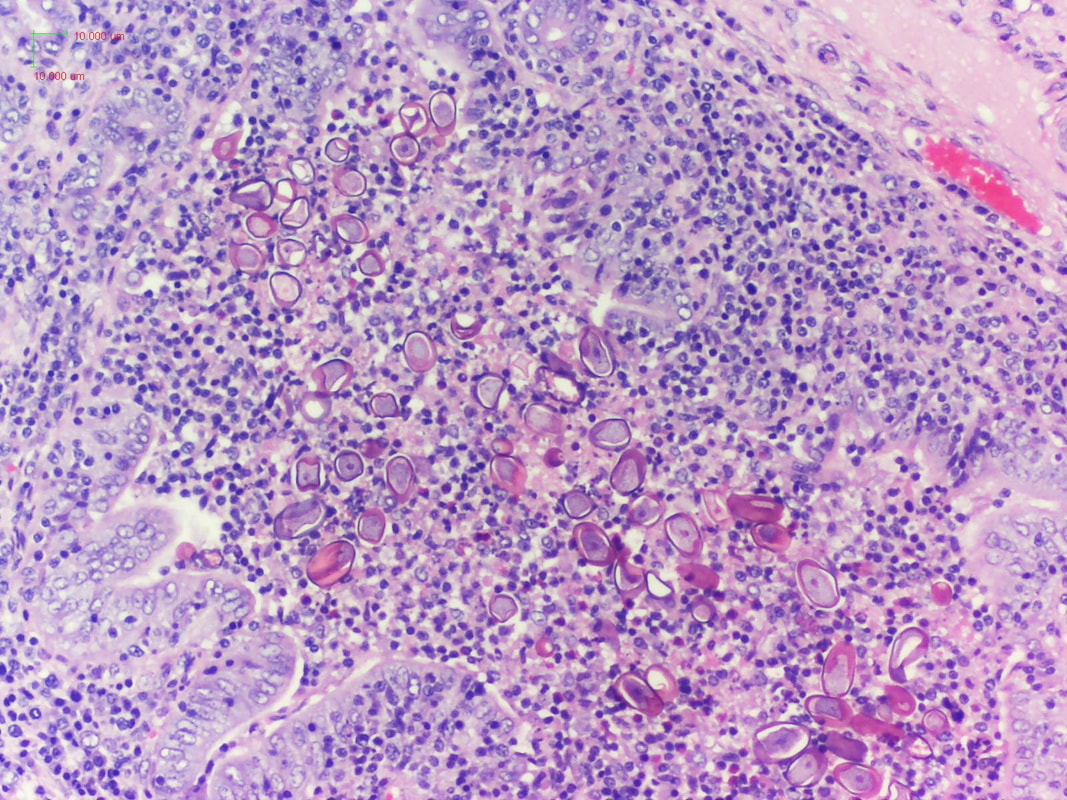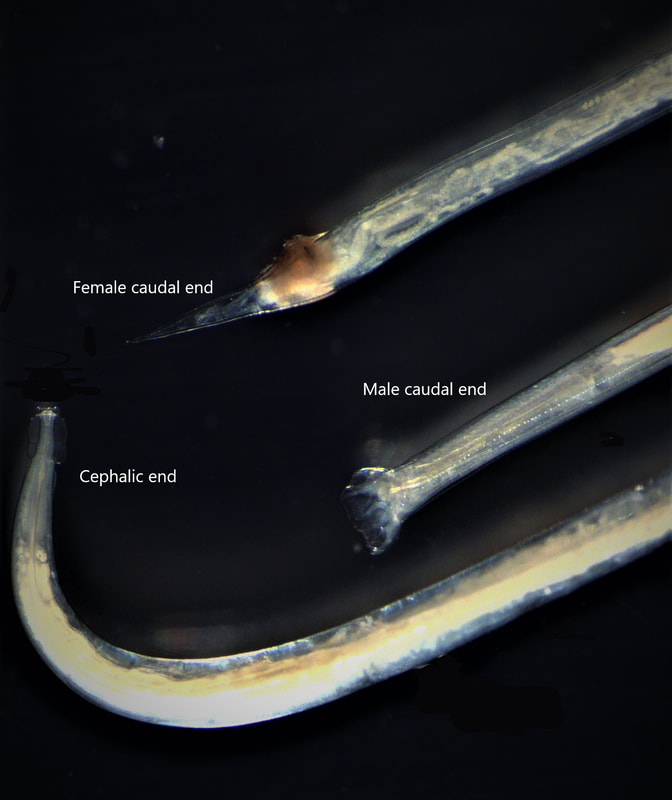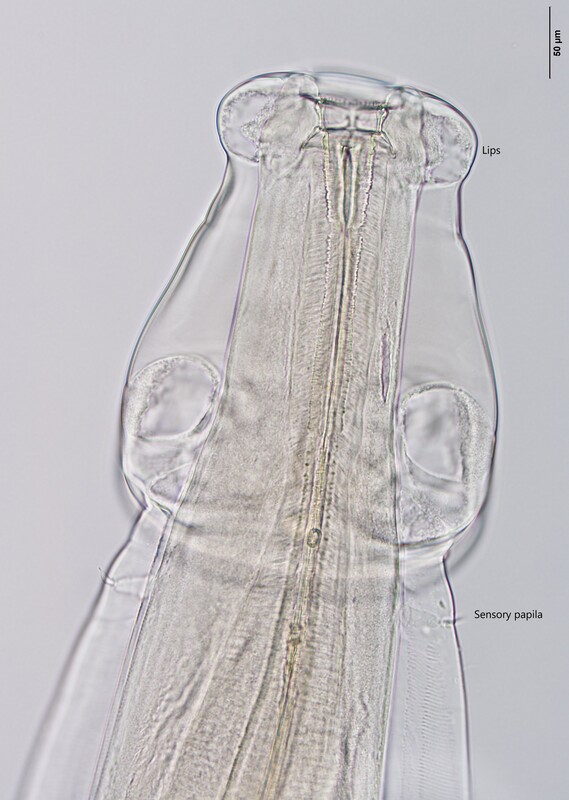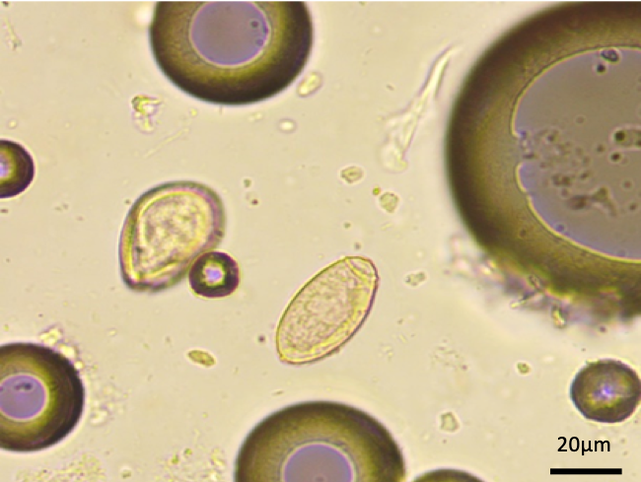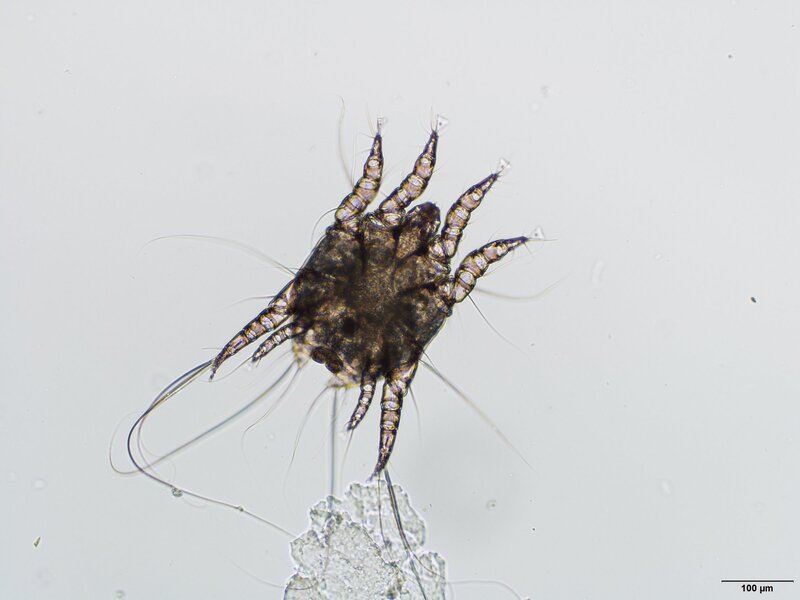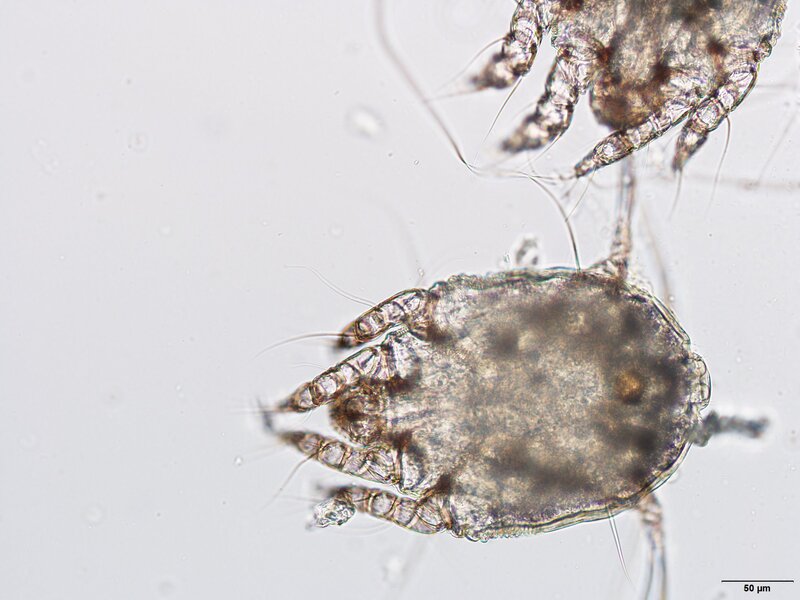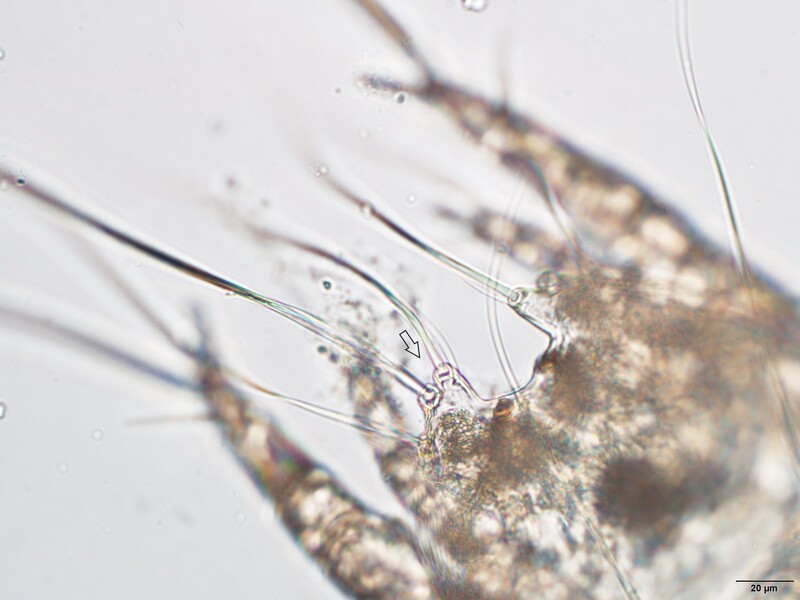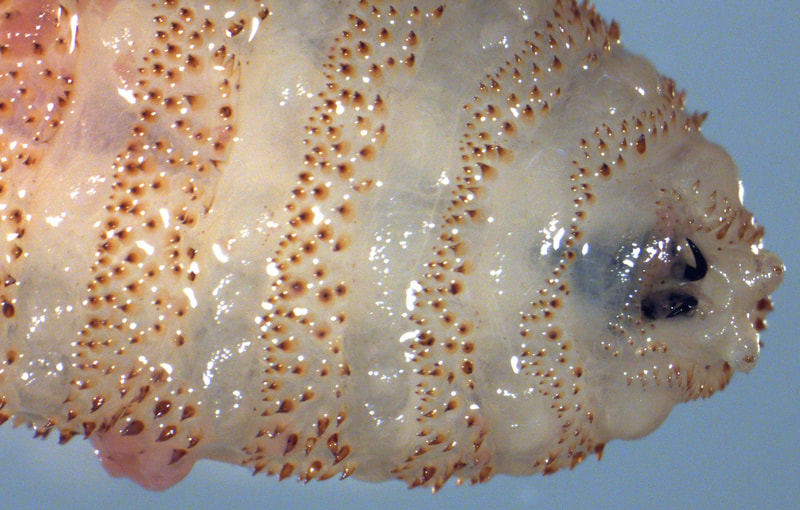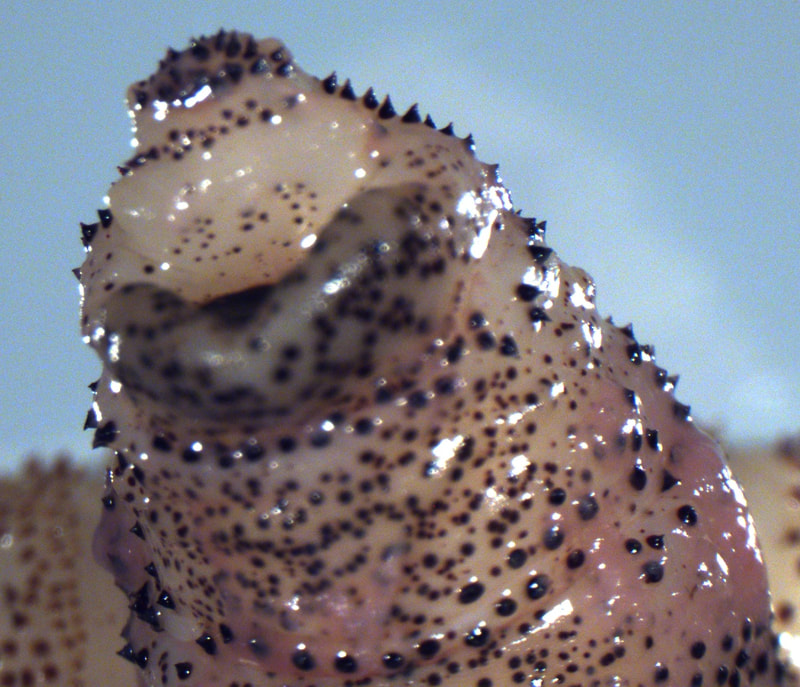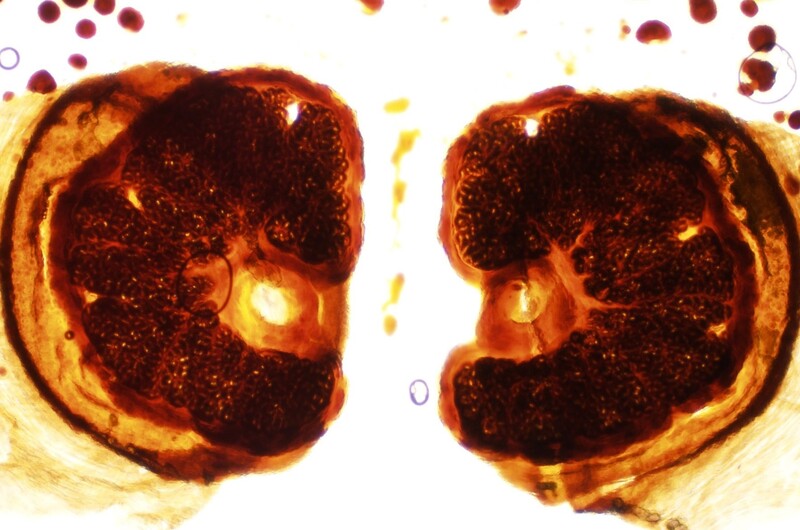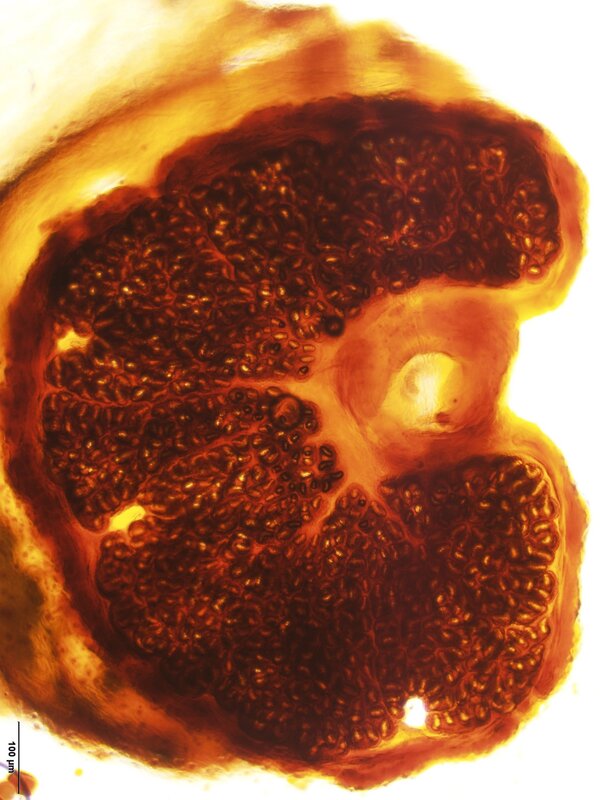More than just allergies...A one-year old Spanish goat was submitted to the Oklahoma Animal Disease Diagnostic Lab for necropsy examination. As an incidental finding during necropsy, the following (Video) was discovered in the right frontal sinus. Video 1: Larva recovered at necropsy 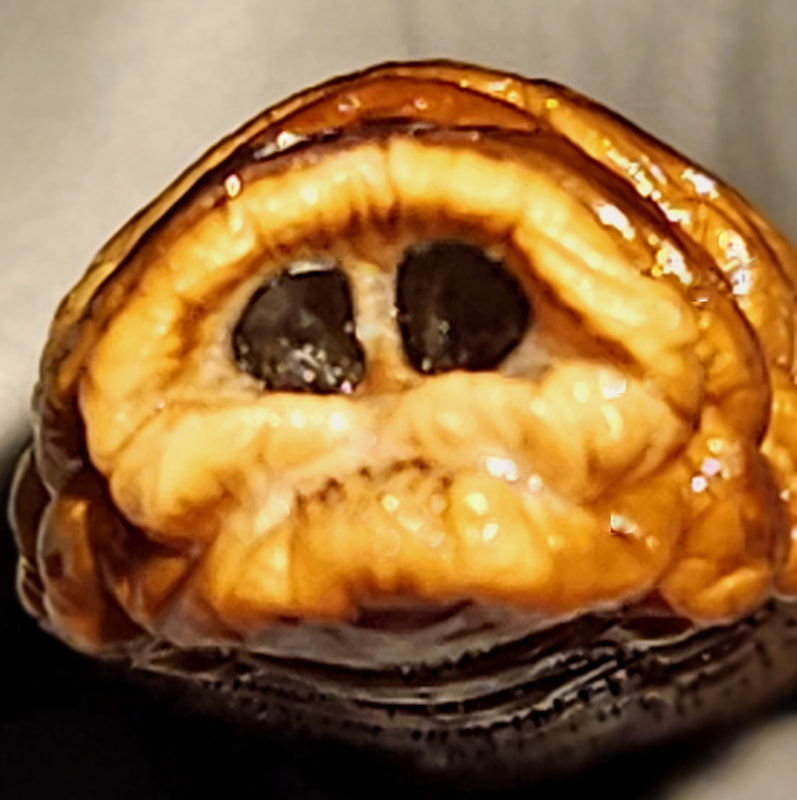 Image 1: Posterior spiracles of recovered larva Oestrus ovis, larva third stage (L3). The nasal botfly, is a small fly ~ 1cm long with vestigial mouthparts. They are active during warmer hours of the day, depositing larvae (L1) in the nostril of sheep. The L1 crawls onto the mucous membrane of the nasal passage remaining there for about 2 weeks, or in arrested stage during the winter. The larva then moves to the frontal sinuses where they reach the L3 stage. After full development, the L3 larva crawl down into the nasal passages and is expelled by the sheep’s sneezing. O. ovis larvae are not pathogenic, but heavy infestation can cause, nasal discharge, sneezing and partial blockage of the nasal passages. Diagnosis is made by location of the larva on the host and morphology of spiracles. (Image 1) Although these larvae are commonly called the sheep botfly, larvae have been also found in deer, goats, and cattle. There are also reports of horse, dog and human infestation. Unlucky rabbitsA juvenile female rabbit was presented for necropsy at the Veterinary Medical Diagnostic Laboratory, University of Missouri. The rabbit was part of an ongoing case of about 200 rabbits displaying various clinical signs including diarrhea, and observation of Eimeria spp. oocysts during fecal examination. At necropsy, white foci (1-3 mm diameter) on the liver and kidney were observed grossly. The following was observed during histological examination of the liver: Image 1: Histological liver preparation. Thanks to Dr. Alexis Carpenter, DVM and pathology resident at the University of Missouri, for providing the histological image and anamnesis of the case. Hepatic coccidiosis, caused by Eimeria stiedae. Some rabbits are asymptomatic; however, the disease can be fatal, especially in young rabbits. Heavily infected rabbits show signs related to decreased hepatic function and bile duct obstruction. Anorexia, debilitation and diarrhea or constipation can occur. The abdomen might be enlarged, and the animal may be icteric. Infection results from ingesting sporulated oocysts that undergo excystation in the duodenum. Enlargement of the liver, gall bladder, and bile duct may be seen at necropsy with multi-focal nodules caused by hyperplasia and cystic enlargement of the bile duct epithelium. Various life cycle stages of the organism may be seen histopathologically with oocysts in bile duct lumina. Unthrifty cowThe following parasites were recovered during necropsy from the cecum of a 4-year old cow with no deworming history. The cow was malnourished and with a high burden of gastrointestinal parasites. Image 1: Worms recovered during necropsy. Image 2: Anterior end cuticle inflations or vesicles. Oesophagostomum radiatum, is a nematode that lives in the large intestine, primarily the cecum of cattle. The adults measure about 2 cm in length and their anterior end has cuticle inflations or vesicles (Image2). The eggs are 70 to 90 × 34 to 45 µm, thin shelled, and segmented when passed. Before current anthelmintics, Oesophagostomum was an important parasite during cool, wet seasons. Oesophagostomins have a direct life cycle. Once in the gut, larvae penetrate the intestinal wall into the mucosa and molt to L4, which emerge in 7 to 10 days in a susceptible host. In hypersensitive hosts, nodules surrounding larvae are formed. The larvae may remain within the nodules for up to a year. These parasites are also called nodular worms. Indiana Newcomer!A 3-year-old, male, intact domestic shorthair cat showed signs of anorexia, vomiting, drooling, tachypnea, ataxia, and twitching. The cat tested positive for Feline Infectious Peritonitis. He did not respond to treatment and died due to Cardiopulmonary arrest (CPA). Necropsy was performed at the Indiana Animal Disease Diagnostic Laboratory, Purdue University. This parasite egg shown in the image was an incidental finding on centrifugal fecal flotation performed using Sheather’s solution. Image 1: Ova found on fecal examination (400x magnification) This month’s case was a contribution of Dr. Vishnu Manikantan, Purdue University. Opisthorchids are trematodes residing in the gall bladder and bile duct of many vertebrates. The eggs (22-35µm X 11-19 µm) are thin-shelled and operculated with a yellowish-brown color. The presence of a prominent lip around the rim of the operculum and the adjacent shell is a distinguishing feature of these eggs. In cats, Metorchis conjunctus, M. albidus, and Amphimerus pseudofelineus are the Opisthorchids reported from parts of the United States and Canada. Parasites belonging to the family Opisthorchiidae have an indirect life cycle involving two intermediate hosts- mollusks and freshwater fish. Opisthorchid infection is not known to create severe health effects in the definitive host. Nevertheless, there have been occasional reports of clinically significant liver damage. Eggs can be recovered using centrifugal fecal flotation, but sedimentation tests are preferred. The "mite"mare before ChristmasA 2-year-old African Pygmy Hedgehog, was presented with history of mucoid diarrhea for the past 24 hours. A centrifugal fecal flotation was performed and several of the following mites were observed. Image 1 & 2: Mites found on fecal flotation Image 3: Arrow pointing to trilobate laminate projection Caparinia tripilis are Psoroptid mites that infest hedgehogs as well as other mammals. The mites feed on skin cells and epidermal debris. Two species are known to infest hedgehogs, C. tripilis and C. erinacei, with the first one being more pathogenic and forming clusters on its host. Caparinia tripilis has a posterior end of the abdomen with trilobate laminate projection on either side and contain a long seta (Image 3) while C. erinacei has two bilobate laminate projections. The mites burrow into the skin of ears, head, and sides of the legs causing irritation, pruritus, and self-trauma that can lead to infection. On this case, the mucoid diarrhea was not caused by the mite infestation. Oh deer!A white-tail deer from a Northeast Oklahoma farm, was submitted for necropsy to the Oklahoma Diagnostic Laboratory during the month of August 2022. During necropsy the following larva was found on the esophagus. Images 1-3: Larva found in the esophagus Images 4-5: Posterior spiracles of recovered larva Hypoderma lineatum, also called heel flies or gadflies. The adult flies deposit eggs on the hair of cattle, deer and sometimes horses. The eggs hatch within a week and migrate through the connective tissues of the host. The larva of H. lineatum accumulate in the esophagus during migration and remain there for about 3 months. After, they migrate to the subcutaneous tissues of the back, forming lumps or warbles and cutting breathing holes in the skin of the host. When the larva emerges from the warble they measure approximately 25 mm long with a light brown color. |
Archives
April 2024
Have feedback on the cases or a special case you would like to share? Please email us. We will appropriately credit all submittors for any cases and photos provided.
|

